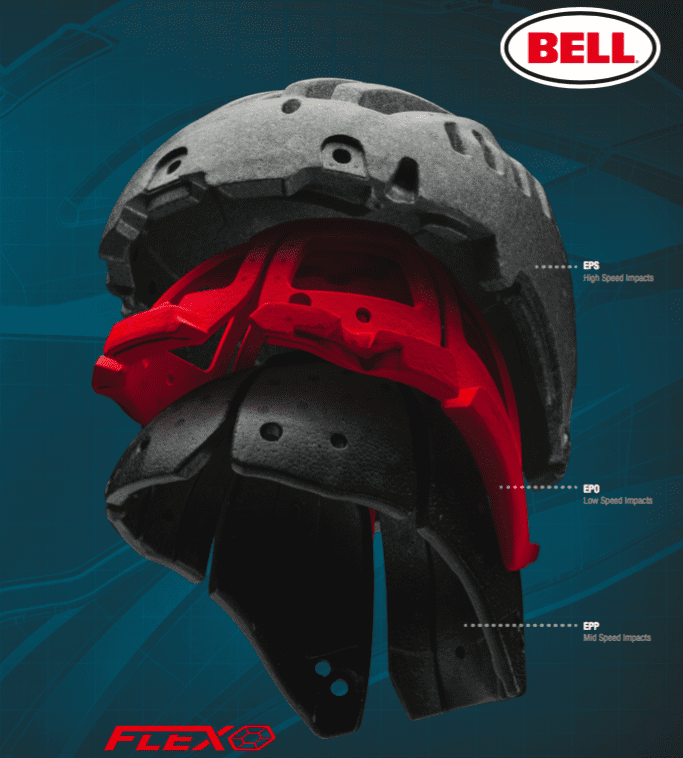The helmet market is increasingly driven by technological change, brands engaging in a never-ending war to come up with the safest and most user-friendly helmet. It’s a battle not foreign to Bell , which has been responsible for some of the most significant advances in helmet design, starting with the introduction of the ‘jet’ open-face helmet in 1954 and later the full-face in 1966.
Recently, Bell has not been afraid to source external technologies and has worked with outside companies to improve its helmets. In the case of variable visor tint technology, Bell collaborated with Transitions Optical to arrive at the best solution.
True to its roots, Bell continues to bring to fruition its own ideas. Its most recent in-house advance has been the Bell Flex Impact system to improve both helmet fit and performance. Bell introduced the Flex Impact liner in its Moto-9 helmet in 2014 and this year has added it to both the Pro Star and Race Star helmet models.
Flex Impact
The Flex Impact liner features exclusive progressive layering technology, a system of three unique protective materials designed to handle impacts at low, middle and high velocity, as well as rotational impact, to deliver optimal protection.
The next step is adaptive fit, a segmented construction that automatically conforms to a rider’s head for a better fit and more predictable energy management.
Rotational energy management comprises a ‘slip zone’ within the impact liner that allows for subtle movement between the inner layers that works to reduce rotational energy transfer from angular impacts, which can mean the difference between a serious and critical head injury. It combines with Bell’s Velocity Flow Ventilation system for an even cooler helmet.
Textreme
For 2016, Bell set out to re-establish its flagship model with the introduction of the Pro Star. Bell sought to reduce the weight of the shell by incorporating patented Swedish material Textreme into the layup. The weight of the shell was reduced by 21 per cent without sacrificing any mechanical properties.
Textreme spread tow (yarn) carbon reinforcements are employed to produce optimised reinforcements for ultra-light composites and are used in bicycles, Formula 1, NASCAR, surfing, ice hockey, aerospace, industrial applications and the America’s Cup.
MIPS
Earlier this year Bell adopted the patented MIPS (Multi-Directional Impact Protection System) within several of its higher-volume helmets. The technology, first offered in its bicycle lids, is designed to manage energy from rotational and angular impacts, and is available in three Bell models– MX-9, MX-9 Adventure and Qualifier DLX.
MIPS uses a slip-plane system that moves inside the helmet, mimicking the brain’s own protection system. This low-friction layer under the impact liner is designed to rotate inside the helmet with the intent to potentially slow or reduce the amount of energy transferred to or from the head. The MIPS liner is connected to the outer liner by four elastomeric bands that provide 10-15mm of movement in all directions.
When a head rotates quickly and comes to a sudden stop, the rotational acceleration can cause the brain tissue to experience high levels of strain. The stretching of the tissue that can be caused by these motions can result in various types of brain injury. MIPS addresses this strain by allowing the head to slide independent of the helmet during the most critical milliseconds of impact. The slide that occurs during that time helps reduce the violence to the brain inside the skull, and can significantly reduce the risk of traumatic brain injury.
Transitions SOLFX
Bell and photochromic pioneers Transitions Optical teamed up to create the Transitions SOLFX ClickRelease shield, which automatically adapts to light conditions, darkening when exposed to sunlight and clearing in low light.
The shield tint automatically and quickly adapts to lighting conditions. It can go from fully clear to dark tint in about 10 seconds, and Bell’s NutraFog II anti-fog coating reduces fogging.
Transitions SOLFX is compatible only with Bell’s ClickRelease helmets, the Star, Vortex, RS-1, Qualifier and Revolver.












